Introduction
Music can be described as both traditional and modern where traditional music is seen as old and longstanding, while modern music is contemporary and present. Arguably, traditional music has influenced what is today referred to as “modern” music in various ways. Critically, many aspects of the music produced today can be traced back to indigenous groups all over the world. Culture is extremely intertwined with music such that slaves from Africa carried their tunes and influenced music in other parts of the world (Griots 00:00:10-00:07:13). For example, what is today known as “riddims”, originating from Jamaica, has the same concepts as the country’s traditional tunes. In the given example, one musical tune is used to produce various types of songs similar to how Jamaicans used the banjo to make a majority of their music. This presentation looks into the world’s music, taking samples from several countries and cultures.
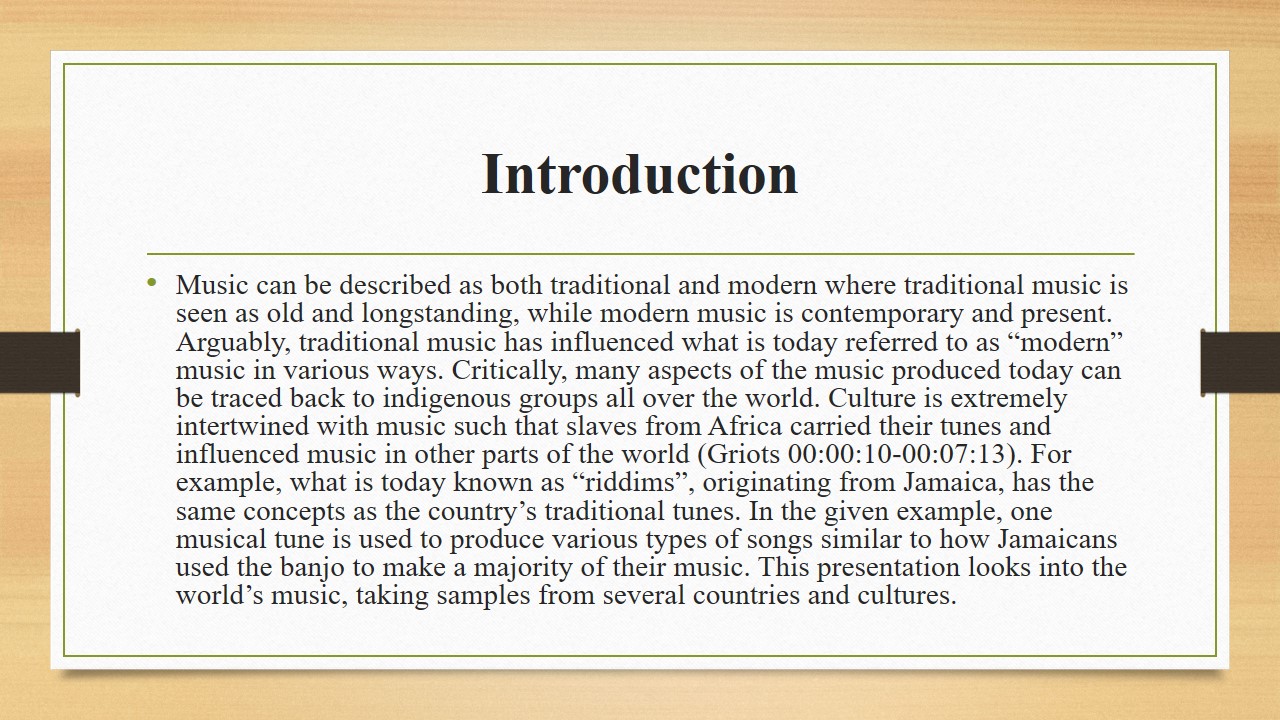
Music of Africa
Traditional music from Africa was mainly played during special occasions, giving them either an upbeat for celebrations or slow tunes for sad events. In Zimbabwe, the mbira dza vadzimu, which resembles a child’s music box lays foundation to all its tunes (Miller and Shahriari 380). Professionals would pluck the individual strips at different speeds to make music. The mbira dza vadzimu can be linked to the culture of the people as the tool is used for ritual purposes and only special people are allowed to play it. Indeed, whereas a significant number of modern music from Zimbabwe are based on western music, the underlying tones are borrowed from the mbira. The up and down nature of the music box also pays tribute to the terrain in Zimbabwe, which has high plateaus and mountains. Additionally, the design of the tool has been associated to the Victoria Falls, which the country shares with Zambia.
This can be compared to Uganda where music has a much faster tempo. Their traditional instrument is referred to as the akadinda, a large xylophone (Miller and Shahriari 358). This instrument can play 600 beats per minute and is made up of the banana bark. Bananas, locally referred to as “matoke” are the country’s staple food. The bark is not only easy to get but also represents something the community values. The instrumental tool focuses on fitted musical pieces paying tribute to the communal nature of their culture. It is played by four or six men who have to practice their roles in order to ensure harmony. The fast-paced music is often accompanied by fast moving dance moves as well. The dancing is mainly done by women and children, as the men play the instrument.
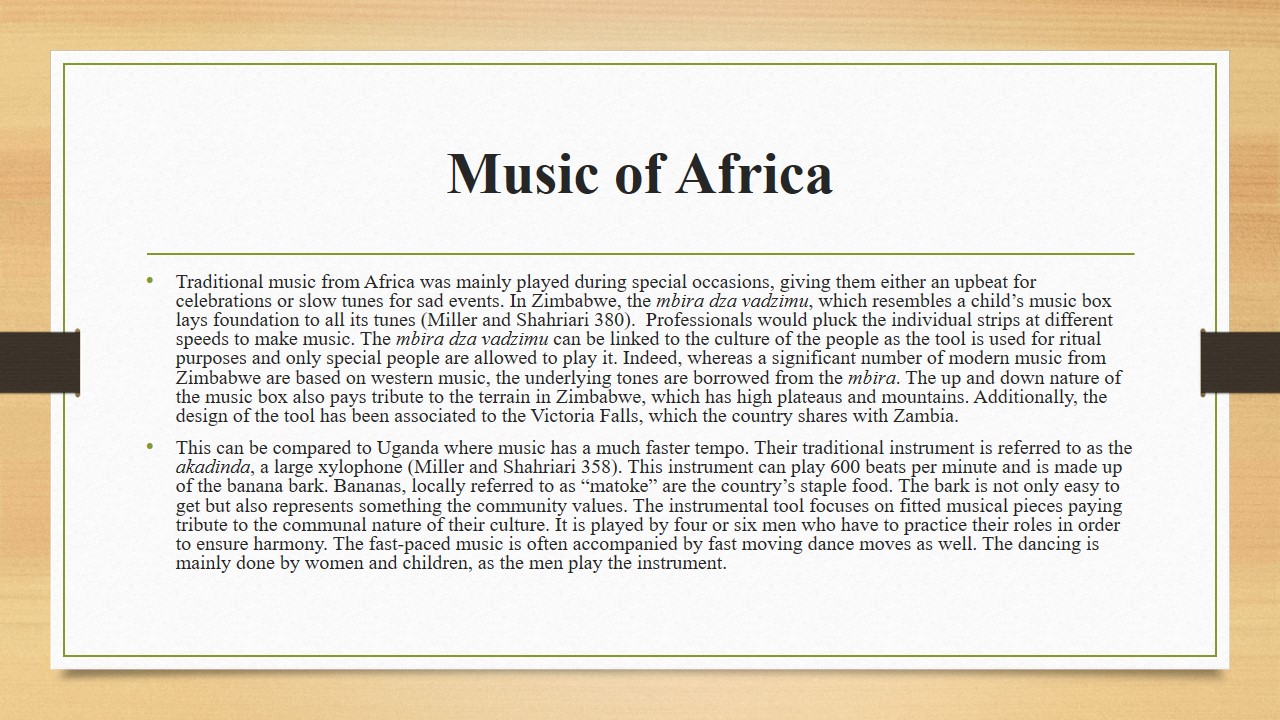
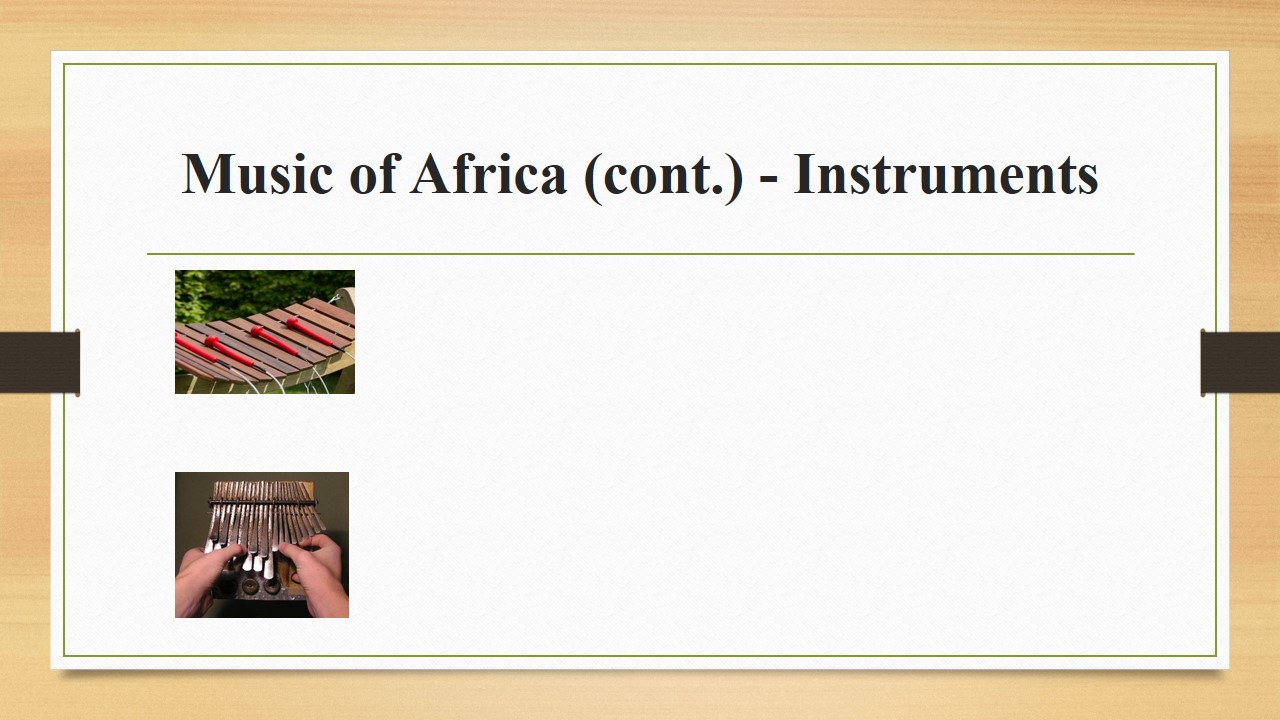
Music of the Caribbean
There are several countries that are clustered together and referred to as the Caribbean. This section will look into music from Cuba, Haiti, Trinidad and Tobago, and Jamaica. In Cuba, soulful Spanish music mixed with African percussions reveal the vibrant culture of the people. Music in the Caribbean has evolved over time. Their traditional danzon is still played during ceremonies and is often considered romantic. Arguably, the danzon led to the birth of the salsa dance. Due to integration, the country also enjoys afro-jazz fusions and rumba, all borrowed from their African heritage. On the other hand, in Haiti, music is mainly for rituals. Although the world refers to the vodou as dark and evil, in Haiti, it is a cultural musical piece that encourages a call response interaction. Also, in Haiti, music is passed from one generation to the next, thus, contributing to the sustainability of their culture. The common Haiti vodou ritual has two parts; vocals and drums and vocal with bamboo wind instruments (Miller and Shahriari 380).
Interestingly, there are some similarities in music in Trinidad and Tobago when compared to those of both Haiti and Cuba. Music in these small islands is characterized by steel band, calypso and soca music (Miller and Shahriari 380). The conga drums can be traced to West Africa proving the adoption of some African musical aspects into the music of the locals of the islands. Additionally, the music in Trinidad and Tobago also has upbeats similar to Spanish tunes, showing the island’s link with their colonizers, Spain. On the other hand, Jamaican music is the most commercial in the Caribbean. Their music is highly influenced by reggae, modern music has evolved to Reggatone and riddims. In Jamaica, music not only for entertainment but also highly political.
Jamaican reggae has been referred to as rebellious music that was used as a voice for the oppressed in Jamaica. Thus, the songs are highly political. For example, the song Smile Jamaica by Bob Marley encourages the oppressed telling them that things will get better despite the tough political and economic times. Indigenous communities also have similar type of music (The Maroons 00:00:23-00:011:29).
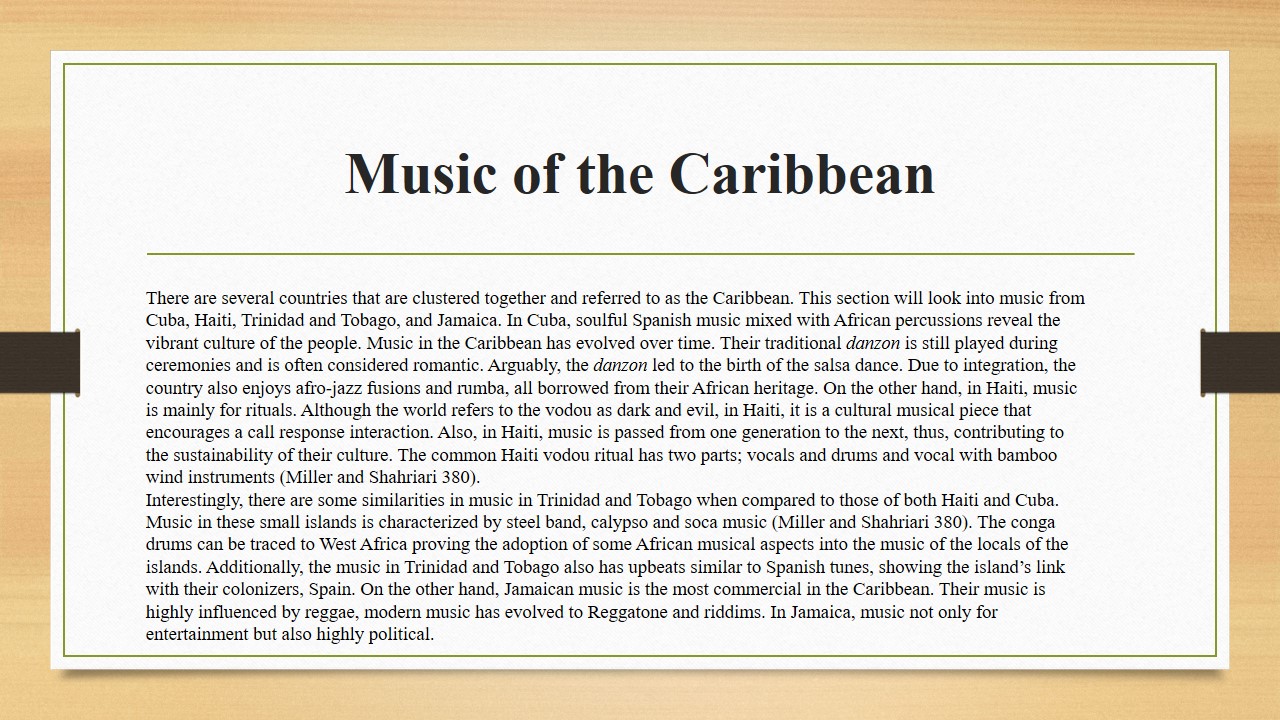

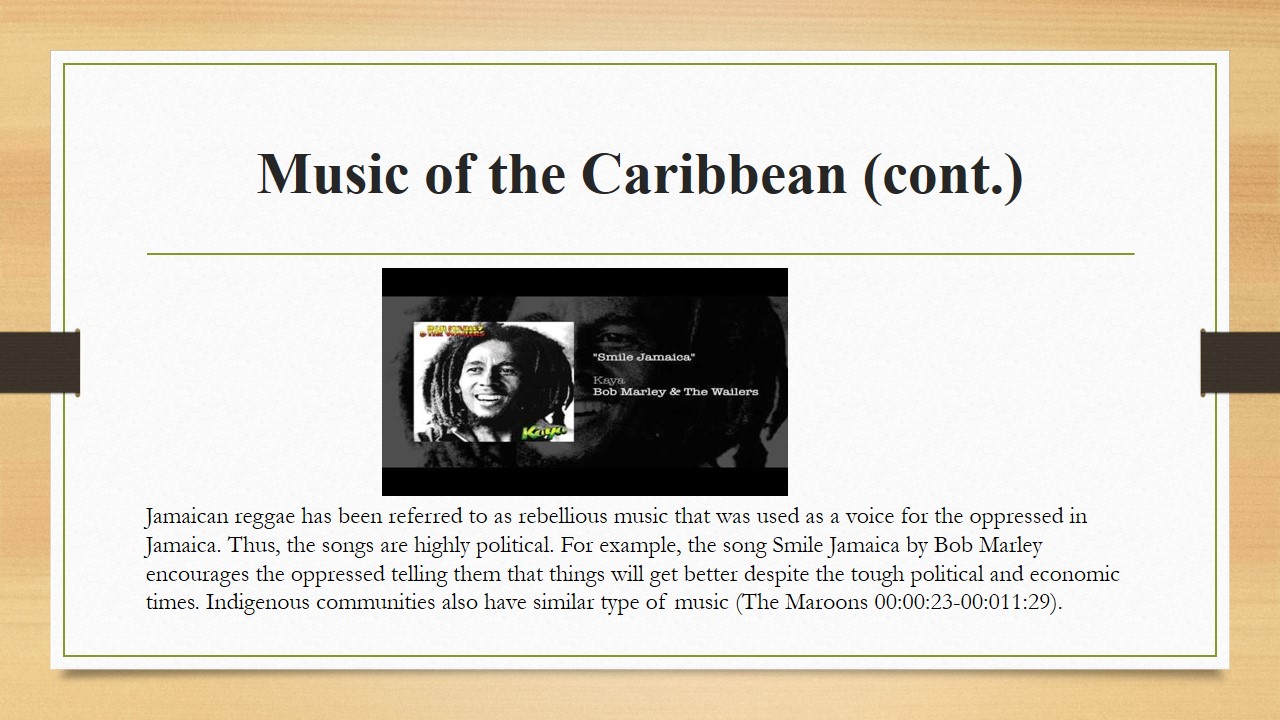
Music in China
Music in China was affected by both economic and political changes. Importantly, the culture heavily borrowed from the country’s landscape, thereby also ensuring that their music paid tribute, to some extent, to their geography. Interestingly, soil and wood became an important part of the Chinese culture. It can be argued that due to the importance of the two elements stated, the traditional Chinese music was extremely “earthy” and “grounded”. Important to mention, iron and bronze became a critical trading factor in the country during the Chinese civilization. Arguably, the country also adopted the same to develop their musical instruments. Initially, music in China was used purely for entertainment. This, however, evolved and the tool has over the last couple of decades also been used as a political propaganda tool (Miller and Shahriari 191).
Indeed, like many other countries, Chinese music was affected by their economic and political changes. The culture of the Chinese comes out in their music and musical instruments. For example, they have grouped all their musical tools into eight categories, namely clay, ground, wood, metal, bamboo, stone, skin and silk (Miller and Shahriari 190). As stated previously, all their instruments are made from locally sourced materials. Additionally, their main traditional tool, the guqin, produces meditative and intimidating sounds based on the event. The tool has been used both in times of war and in times of peace. It has been identified as the oldest musical instrument in the world. Interestingly, however, the materials are also used to determine the theme of the music that is being played. Miller and Shahriari explain that the main themes included nature, myths and literature, mood, and musical structure (191).
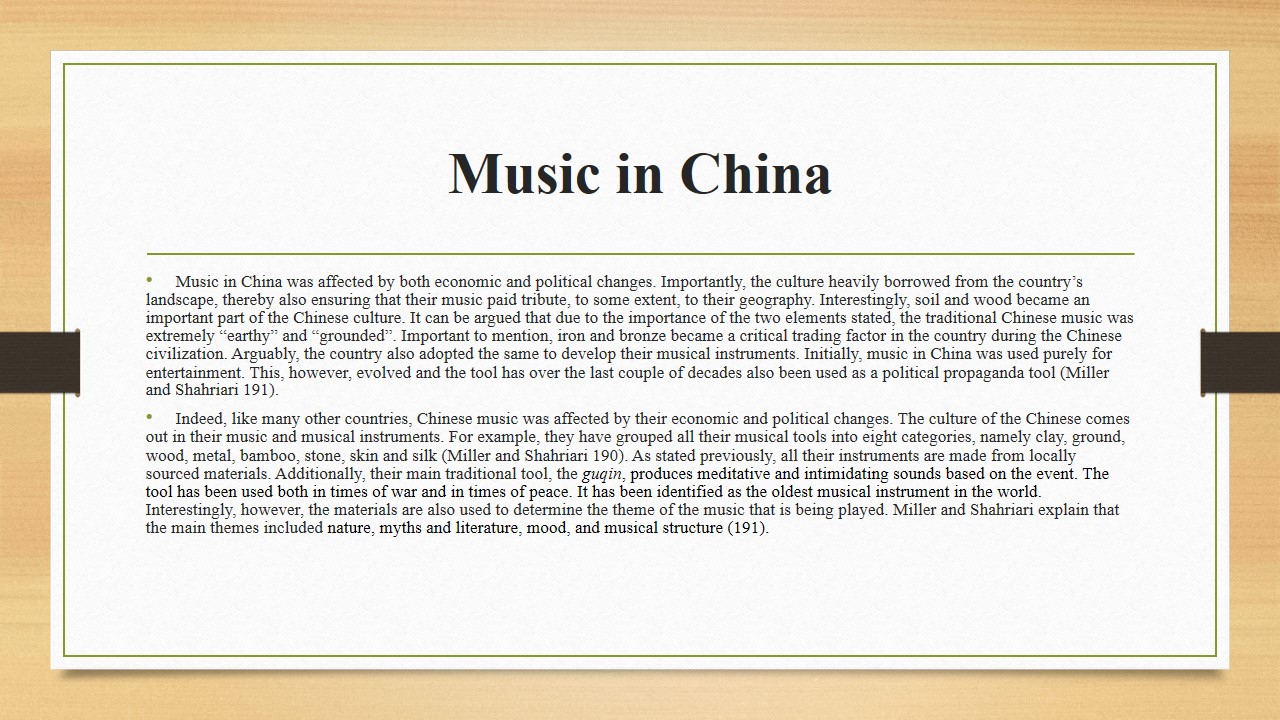
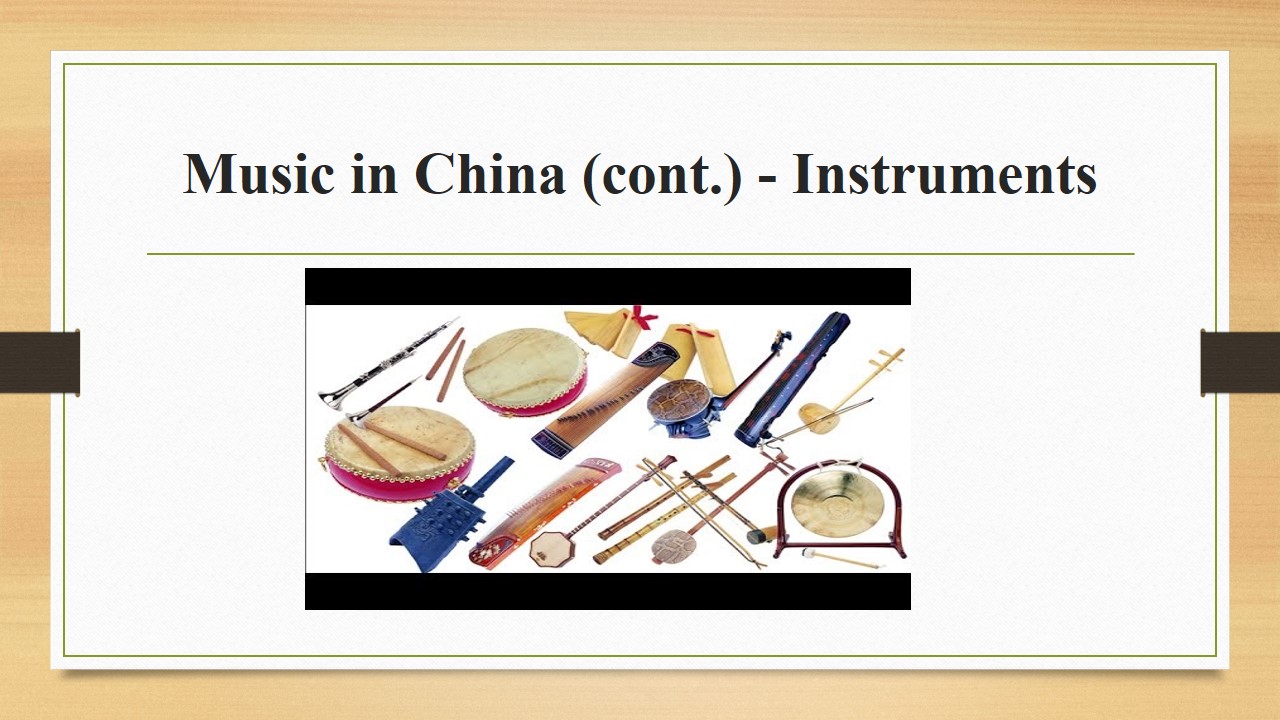
Music in Korea and Japan
Both Japan and Korea’s cultures were significantly affected by the Chinese culture. This is also true about their music which incorporated Chinese culture and musical tunes. The traditional music in Korea is a Confucian ritual referred to as “a-ok” (Miller and Shahriari 218). Arguably, when the country divided into North and South Korea, each of these states took a different direction in regards to culture. Whereas North Korea emulated the Chines culture and significantly adopted Chinese customs, South Korea did not. Because of this, North Korea’s music is very similar to China’s while South Korea’s still uses traditional Korean cultural musical concepts. Due to this, South Korea’s music has become more commercial compared to North Korea’s as it is perceived to be more original, and better synched with the Korean culture. Today, more Korean music is played in the US (Tamar). Both North and South Korea base their music on storytelling, referred to as “P’ansori” (Miller and Shahriari 219).
Critically, Japanese music is minimalist in nature (Sheppard and Sheppard 377). A bamboo flute, referred locally as the “shakuhachi” is the most common musical instrument. Unlike Korea, although Japan’s culture has also incorporated some Chinese customs, much of their music is tied to their original culture. A majority of their musical instruments are made of wood, which is easily found in nature. Like the other countries in Asia, Japanese use music for storytelling purposes as well. Arguably, the minimalist nature of Japanese music is brought on by their landscape. Since the terrain is not as fertile as other states in Asia, Japanese culture is in itself minimalist. The choice of material for their instruments is also based on the fact that bamboo is easily accessible to the community.
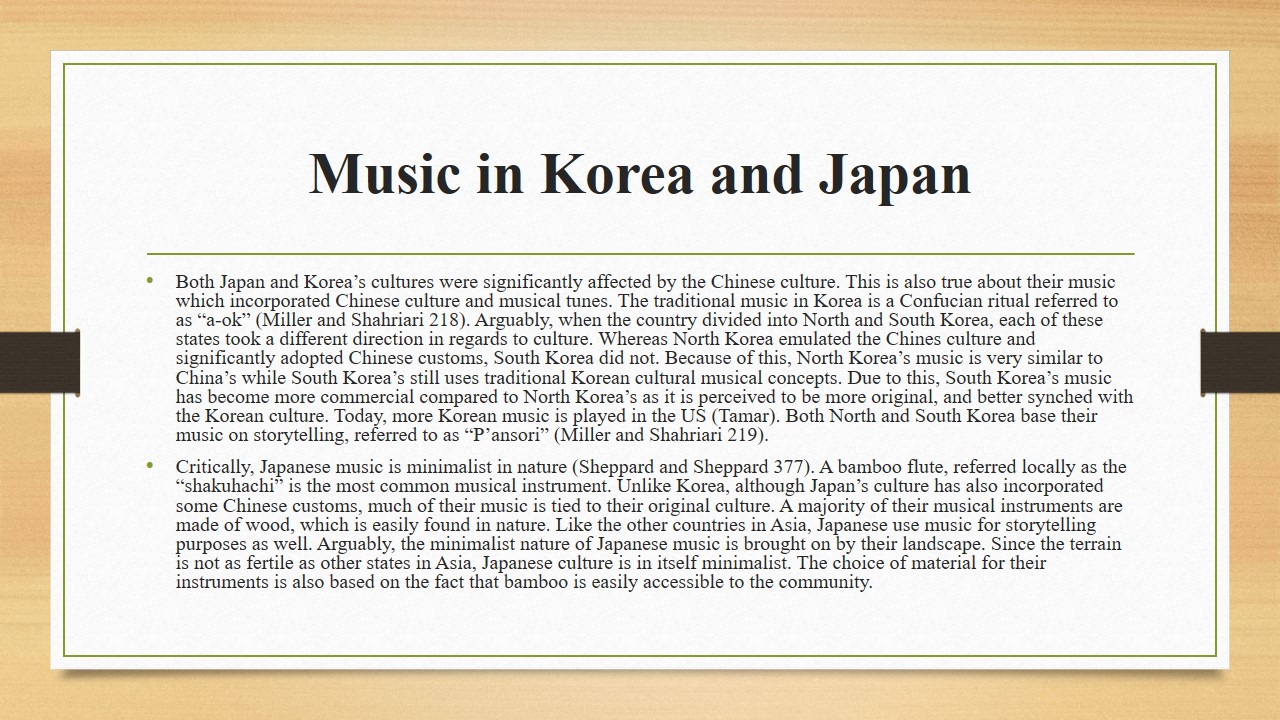
Music in New Zealand and the Amazon Rain Forest
The Maori culture is the dominant way of life in New Zealand. Therefore, a significant amount of their musical culture is tied to the Maori people. Traditionally, the country used two types of songs for purposes of entertainment and information sharing. The waiata was commonly used for festivities and a means of storytelling. Additionally, this category of music was used to enhance the people’s culture and was passed down from one generation to the next. The waiata was accompanied by happy dancing by men, women and children. The second category of music was the haka which was a war cry. Today, the haka is still very common in the country and has been incorporated into sports and other similar competitions. Originally, the Maori used chants as music but developed the rhythmic tunes after colonization (First People in New Zealand 00:00:03-00:06:13). They have several musical instruments such as the “putatara”, case moth, “roria”, and “putorino” (Melbourne 16). Interestingly, a majority of their instruments are small and hand-held (Mantere and Kurkela 95).
On the other hand, in the Amazon Rain Forest, music is characterized by chants and short tunes. The people also have unison group singing with vocal pulsation often used to add rhythm. Arguably, the people’s music is tied to the sounds of the rain forest. Their primary musical instrument is a wooden flute, which is easily made from the trees in the forest. Additionally, they also hit large branches on the ground to make music, engage in feet tapping and hand clapping. As stated, the community in the Amazon Rain Forest gets musical motivation from their surroundings. Their unison singing and call is borrowed from how animals interact with one another in the forest. Their musical instruments are also made from wood that is retrieved from the forest. It is arguable that their music is often calm in tune with nature.
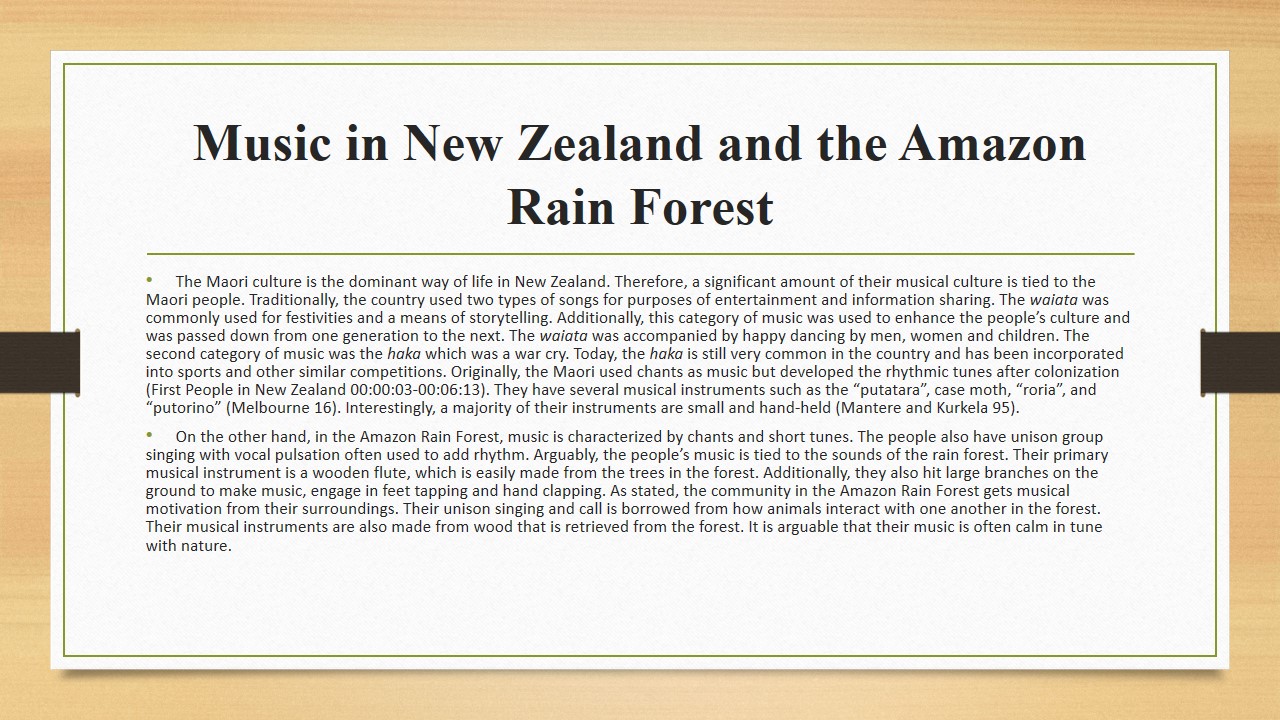
Music in Brazil and Peru
Music in Brazil can be linked to both local and African connections. The country’s most common music is the samba, which is dance music that is characterized by upbeats, shouting and whistles (Miller and Shahriari 440). Additionally, Brazil’s music is also enhanced by the drum and electric guitar. A common traditional instrument is the agogo, which is a samba bell that has been traced back to Africa. Brazil’s music was affected by African culture due to the influence of the slaves who were working in the country. The samba has a lot of percussions, which can also be tied back to Africa. The African percussions were also incorporated into the Brazilian culture to shape their music as known today. It can be argued that their culture was also affected by Spain and the western world. Today, with a significant number of Spanish-speaking individuals, more Brazilian music leans towards its Spanish influence compared to its Portuguese roots.
The musical instruments in Peru give reference to their Alpacas, which are among their treasured livestock. Additionally, the instruments are relatively heavy as they were built to be used by men, although today, many women also play music in the country. Notably, their music is breathy melodic sound (Miller and Shahriari 431). Their traditional instrument is the sikuri panpipe and is mainly played by men (Miller and Shahriari 431). Their music also allows for drums are also commonly used. Like many other cultures that have already been discussed, the community makes their music instruments from locally sourced materials. For example, their drums are made from wood and Alpaca skin. Interestingly, whistles are used to signal a rise in tempo.
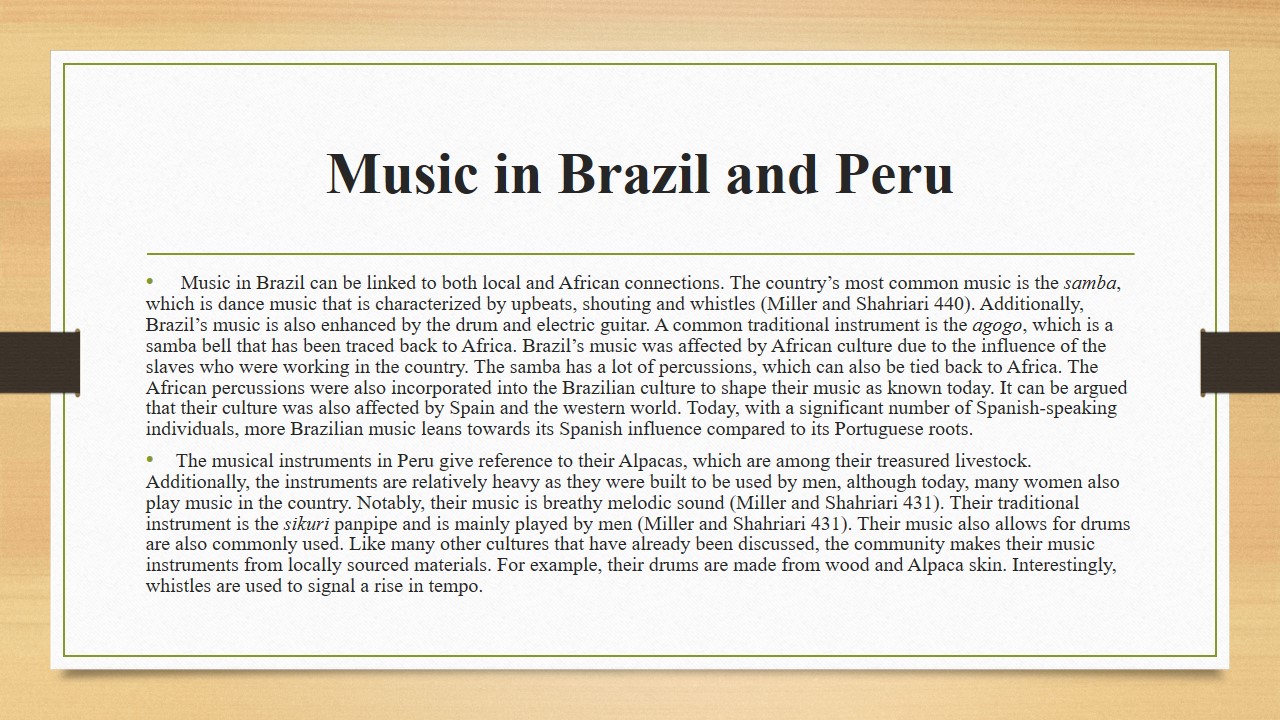
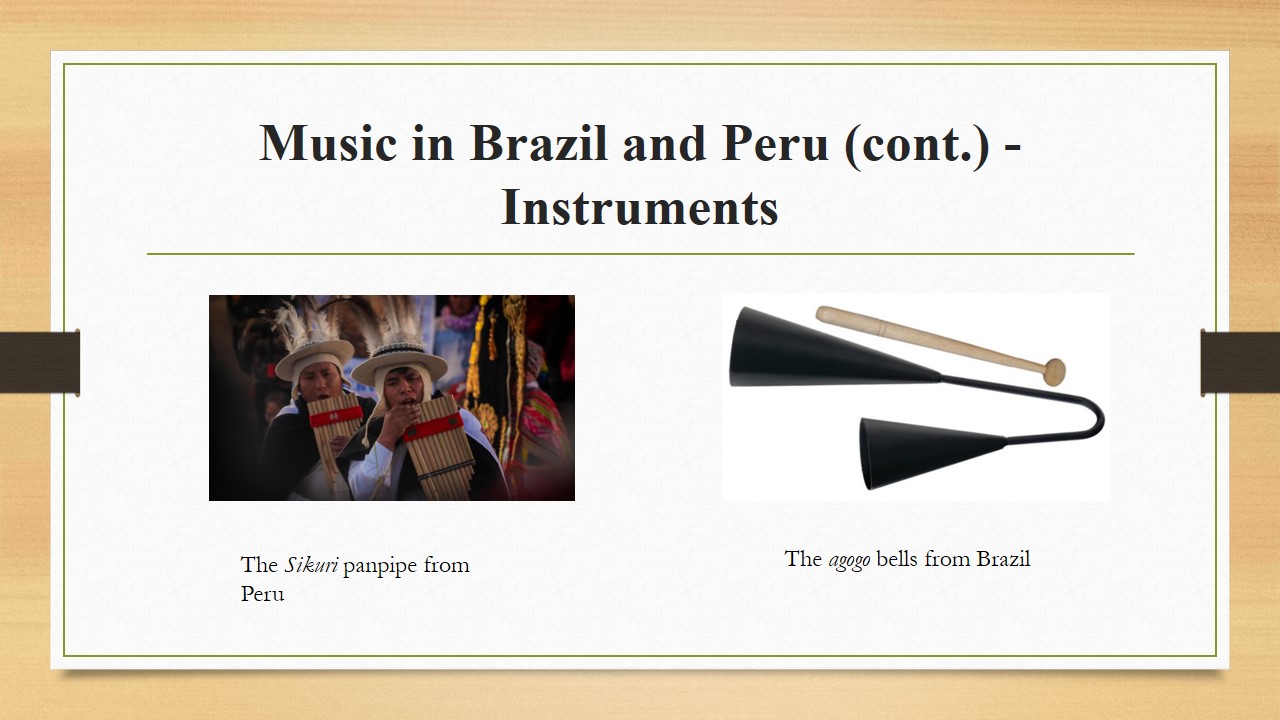
Music in India
India’s music is recognized world-wide due to the sharp nature of its tunes. Indeed, a majority of people all over the world will recognize the pungi, a traditional Indian musical tool, as it is often used by street musicians to charm snakes. It is important to note that whereas culture and religion affected the evolution of Indian music, individuals also played a critical role (Pandit 00:01:23-00:03:13). Mahatma Gandhi is known as the father of India, and he not only shaped the political sphere of the region, but also the social (Mahatma Gandhi 00:00:03-00:05:33). Important to note, music in India is used primary for celebrations and events such as birthdays and weddings. Often, men play the musical tunes while women dance. Music is mainly upbeat and involves belly dancing, which imitates the flexible movements of the snake (Ramona 38).
Indeed, like the other cultures, India’s music goes hand-in-hand with its culture. For example, the caste system is critical in understanding India’s music. The country’s culture divided its population using a caste system based on the level a person was born in. Individuals are not able to move from one caste group to another and are not allowed to marry outside their caste. The same system is applied in their music where different castes were also associated with different types of music and musical tools (Miller and Shahriari 93).
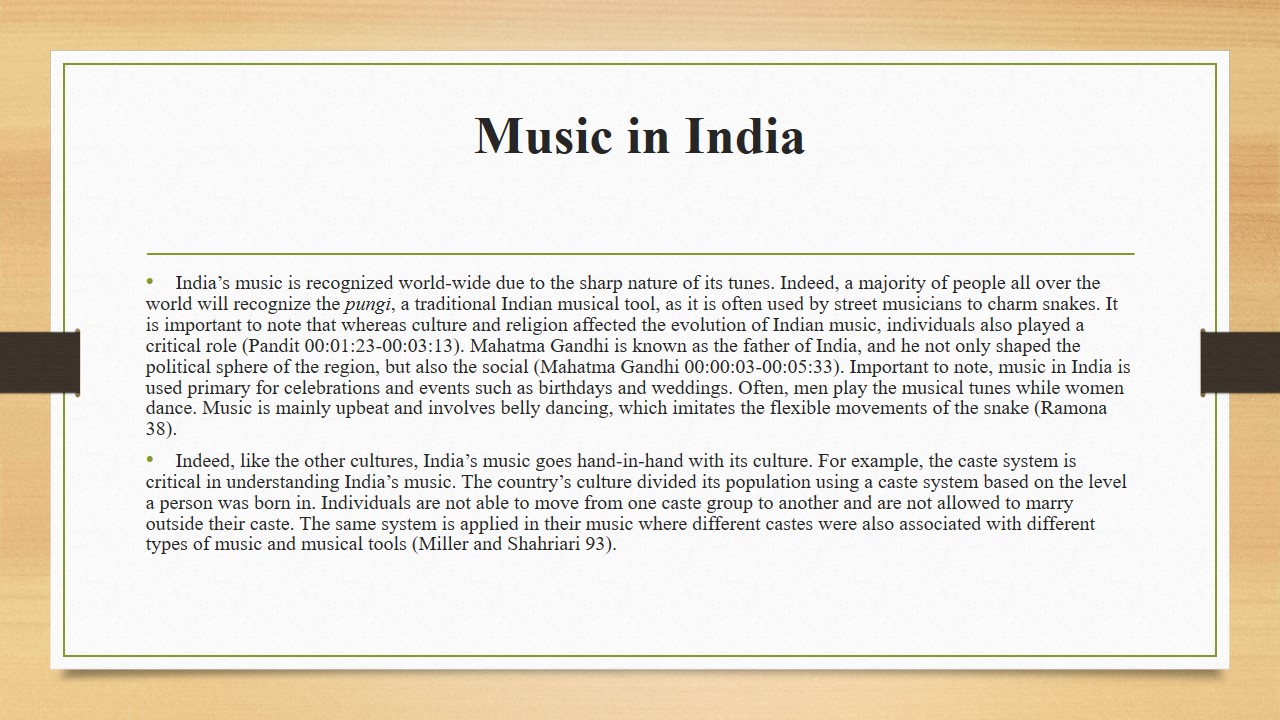
Country that Resonates
I was inspired by the different ways music has been engrained in all aspects of both traditional and modern life. The different countries I visited and communities I engaged with offered a deeper understanding of the relationship between music and culture. Additionally, I was able to also understand how different musical concepts have been borrowed across different communities. For instance, I found it interesting that Chinese music has affected music in Japan, North Korea, and South Korea as well. This goes to show the power of music. Critically, learning from these cultures has also made it easier for me to appreciate the connection music has with different people and the meaning they attach to each of their musical preferences.
A country that I resonate with in terms of its music is Brazil. The music from Brazil completely captures its bright and vibrant culture. One would imagine that it was created in synch with the community’s culture. The fact that it is a combination of both local and African cultures makes it interesting. Additionally, the fact that the country has also taken up musical traits from Spain make it very diverse and interesting.
To make the world a better place, I would use pop culture and music to tell the stories of the evolution of music from different parts of the world. Indeed, many music producers today rely on modern and contemporary tunes to make music. Africa is keen on going back to their roots and using African tunes to make popular music. Musicians such as Fela Kuti have revolutionized African pop music due to this. The fact that such actions have unified a continent even further makes me want to use the same concepts to unify the world.
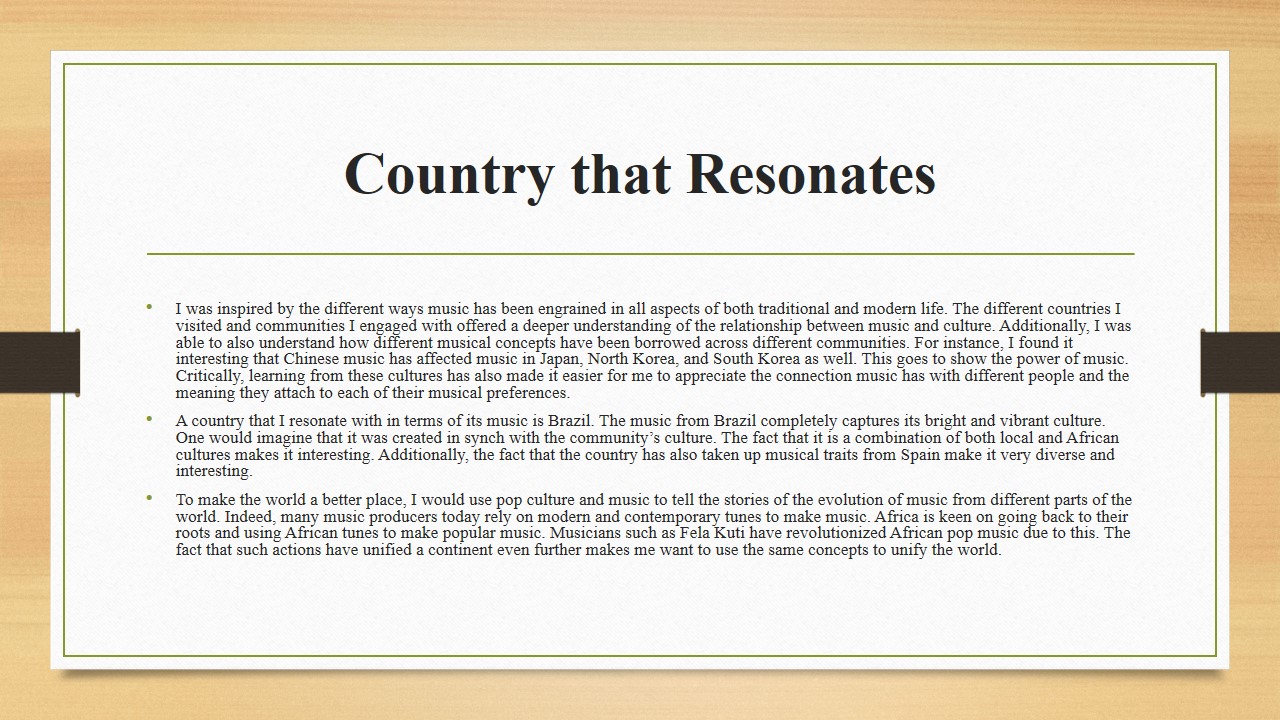
Conclusion
In conclusion, music goes hand-in-hand with culture. This can be proven by both traditional and modern music. In traditional music, tunes were highly connected with the people’s beliefs. Today, popular culture has influenced all aspects of song writing and music production. Interestingly, cultures turned to their geographical landscapes, geographical landscape, interaction with other communities and colonization to also make their music. This resulted in the development of various musical pieces and also musical instruments that have been passed down from one generation to the next. Arguably, music travels space and time and different versions can be found in different communities. For instance, there are African musical concepts that can be found in Brazil, whereas Chinese music is also common in North Korea. The use of music as a storytelling tool has also been well documented in both traditional and modern music.
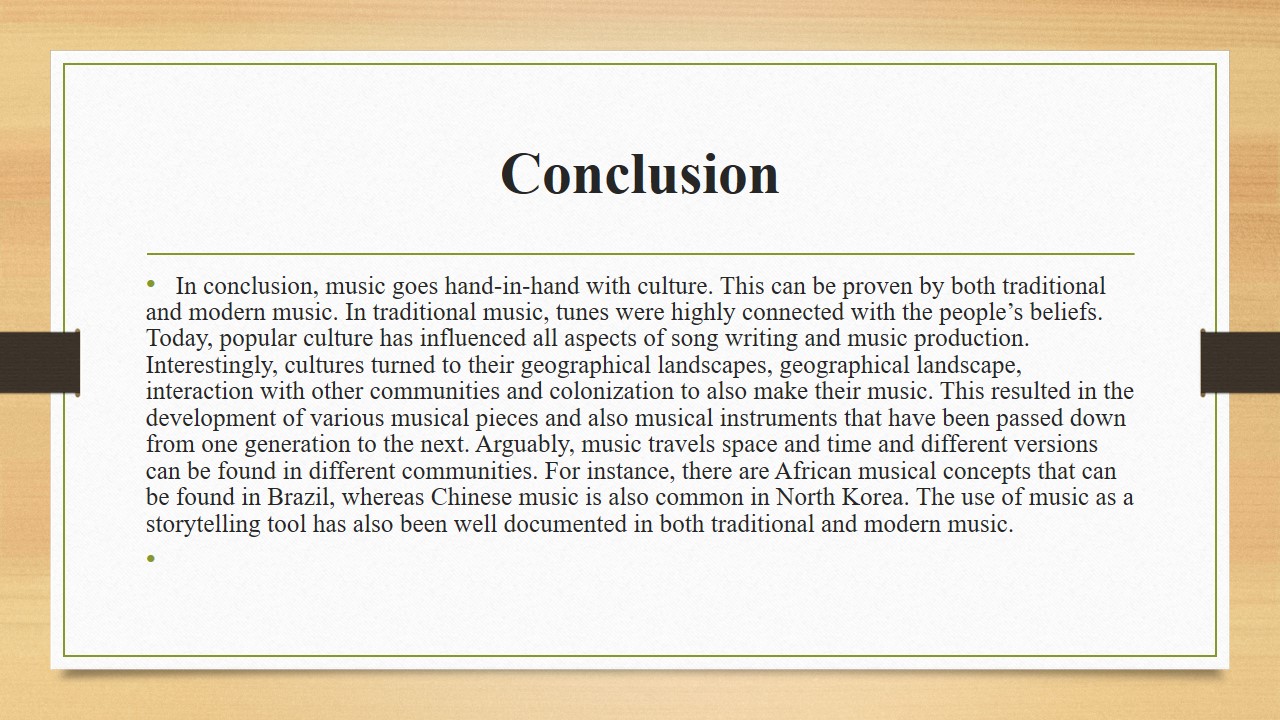
Works Cited
- “Chinese traditional instrument.” YouTube, uploaded by Sanhaun, 2015. Web.
- David-Neel, Madame Alexandra. Magic and Mystery in Tibet. Courier Corporation, 2012.
- “First People in New Zealand: Maori History Documentary.” YouTube, uploaded by History Time. 2019. Web.
- “Griots – The West African Storytellers.” YouTube, uploaded by G Reel. 2019. Web.
- Herman, Tamar. “Why K-Pop Is Finally Breaking Into the U.S. Mainstream.” Billboard. 2019. Web.
- Hill, Nathan. The Historical Phonology of Tibetan, Burmese, and Chinese. Cambridge University Press, 2019.
- “In Cuba They’re Still Dancing (Cuba Documentary).” YouTube, uploaded by Real Stories, 2017. Web.
- Krishnaswami, S. Musical Instruments of India. Publications Division Ministry of Information & Broadcasting, 2017.
- Kurkela, Vesa, and Mantere, Markus. Critical Music Historiography: Probing Canons, Ideologies and Institutions. Routledge, 2016.
- “Mahatma Gandhi – Dying for Freedom.” YouTube, uploaded by DW Documentary. 2018. Web.
- Melbourne, Hirini. Toiapiapi: A Collection of Māori Musical Treasures. Shearwaters, 2016.
- Miller, E. Terry, and Andrew Shahriari. World Music: A Global Journey. 4 ed., Routledge, 2016.
- Mills, Roger. Tele-Improvisation: Intercultural Interaction in the Online Global Music Jam Session. Springer, 2019.
- “Music of India.” YouTube, uploaded by Films Division. 2013. Web.
- “Pandit Vishnu Digamber Pulaskar.” YouTube, uploaded by Films Division. 2013. Web.
- Ramona. Dynamic Belly Dance: The Joyful Journey of Dance-making and Performing. ABI, 2007.
- Rees, M. Lucy. Mongolian Film Music: Tradition, Revolution and Propaganda. Routledge, 2016.
- Sheppard, Anthony William, and Sheppard, W. Anthony. Extreme Exoticism: Japan in the American Musical Imagination. Oxford University Press, 2019.
- “Smile Jamaica (1978) – Bob Marley & The Wailers.” YouTube, uploaded by Bob Marley. 2017. Web.
- “The Maroons. Jamaica’s Forgotten Nation.” YouTube, uploaded by Vagabrothers. 2017. Web.